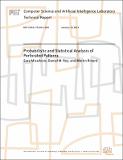| dc.description.abstract | We present a new foundation for the analysis and transformation of computer programs.Standard approaches involve the use of logical reasoning to prove that the applied transformation does not change the observable semantics of the program. Our approach, in contrast, uses probabilistic and statistical reasoning to justify the application of transformations that may change, within probabilistic bounds, the result that the program produces. Loop perforation transforms loops to execute fewer iterations. We show how to use our basic approach to justify the application of loop perforation to a set of computational patterns. Empirical results from computations drawn from the PARSEC benchmark suite demonstrate that these computational patterns occur in practice. We also outline a specification methodology that enables the transformation of subcomputations and discuss how to automate the approach. | en_US |
